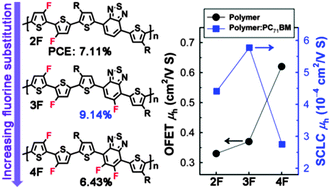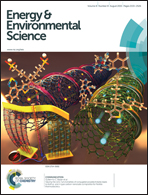Fluorination on both D and A units in D–A type conjugated copolymers based on difluorobithiophene and benzothiadiazole for highly efficient polymer solar cells†
Abstract
Fluorination of conjugated polymers is one of the effective strategies to tune the frontier energy levels for achieving high efficiency polymer solar cells. In this study, three fluorinated D–A polymers, consisting of 3,3′-difluoro-2,2′-bithiophene and 2,1,3-benzothiadiazole (BT) with different numbers of fluorine substitution, were synthesized in order to investigate the effect of fluorination on their photovoltaic properties. The polymers with fluorinated BT show lower frontier energy levels, improved polymer ordering, and a narrower fibril size in the blend with PC71BM. The polymer with mono-fluorinated BT exhibits a superior PCE of 9.14% due to a high SCLC hole mobility, mixed orientation of polymer crystals in the active layer, and low bimolecular recombination. This result demonstrates that the fluorine content in conjugated polymers should be controlled for optimizing optoelectrical and photovoltaic properties of fluorinated conjugated polymers.


 Please wait while we load your content...
Please wait while we load your content...